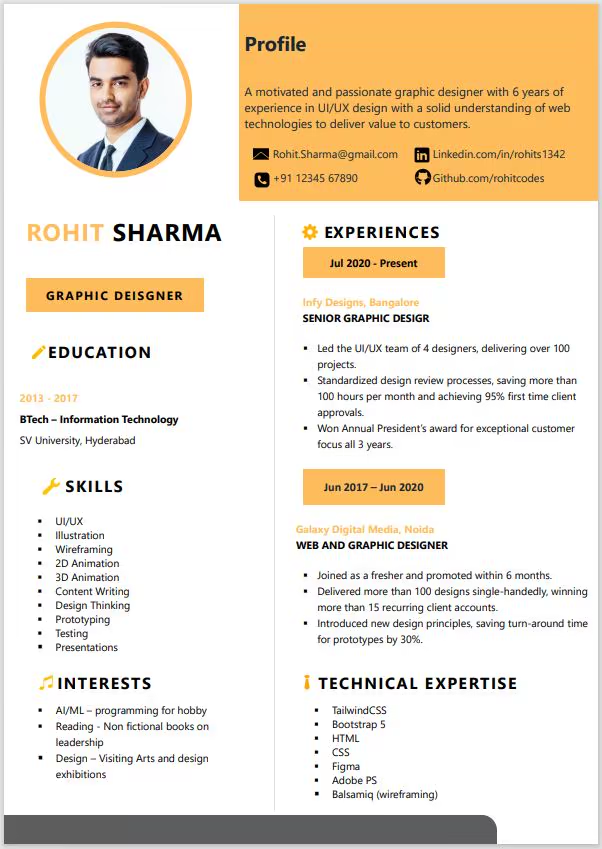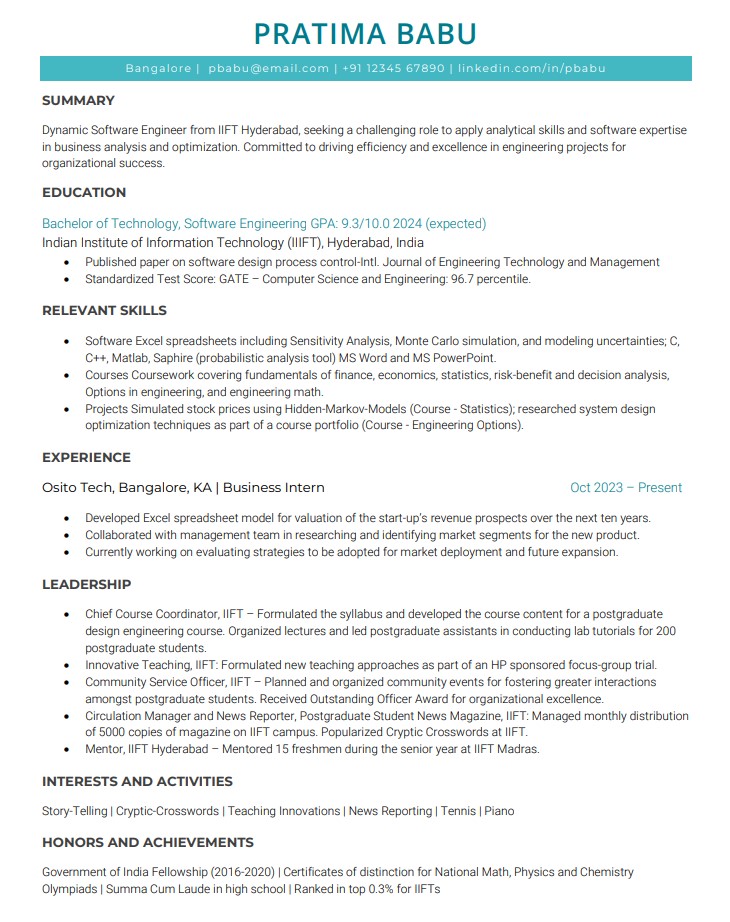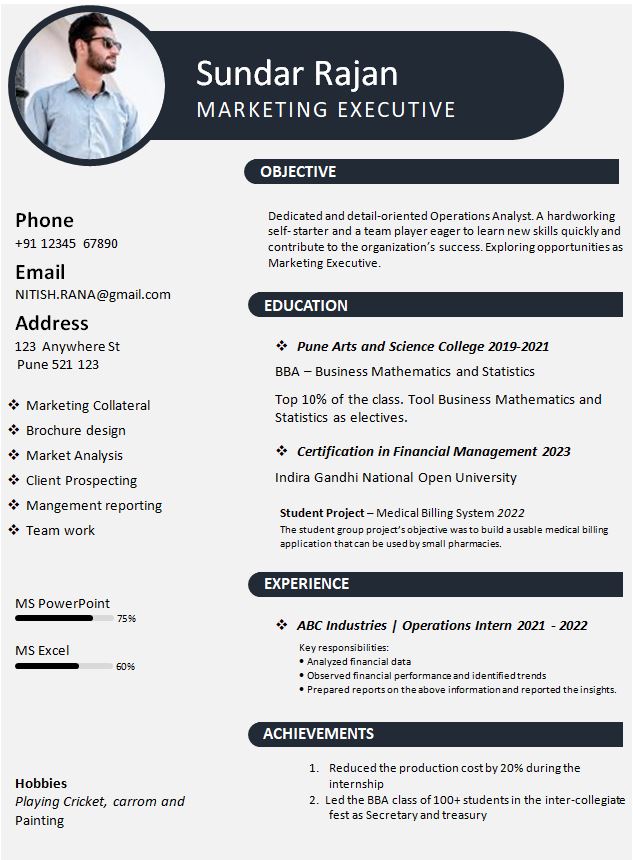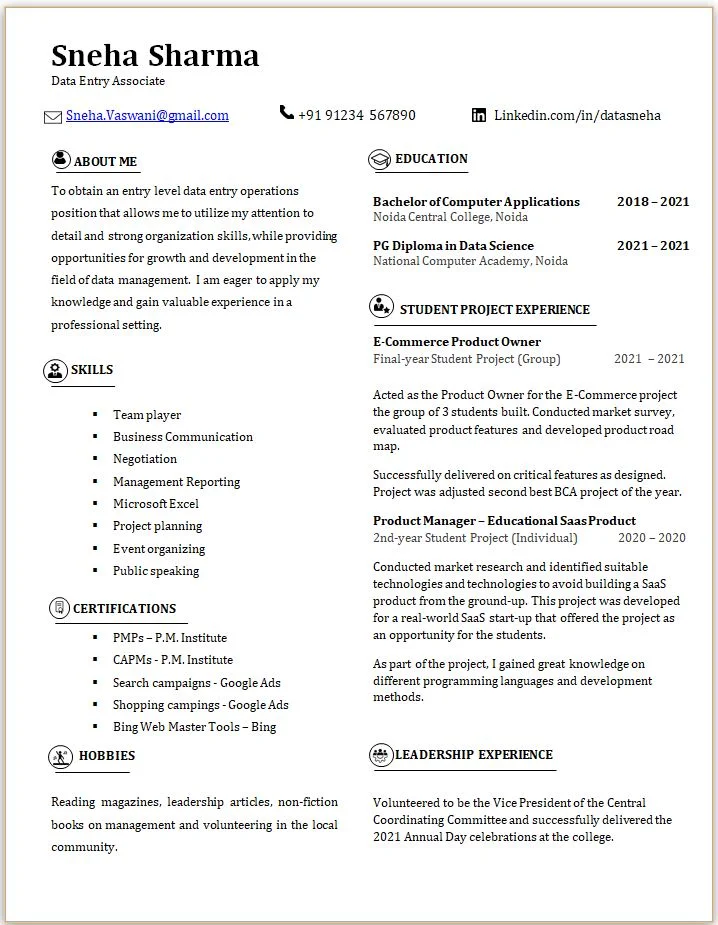Classic Resume
BTech IT Sample Resume
Graphic Designer
Graph


Objective
Here are a few sample objective statements for Graphic Designer resumes.
A motivated and passionate graphic designer with 6 years of experience in UI/UX design with a solid understanding of web technologies to deliver value to customers.
Objective 4 (a simple one)
A motivated and passionate graphic designer with 6 years of experience in UI/UX design with a solid understanding of web technologies to deliver value to customers.
Education
BTech Information Technology, BCA - Bachelor of Computer Applications, MCA - Master of Computer Applications
Skills
Technical Expertise
1. TailwindCSS
2. Bootstrap 5
3. HTML
4. CSS
5. Figma
6. Adobe PS
7. Balsamiq (wireframing)
Skills
1. UI/UX
2. Illustration
3. Wireframing
4. 2D Animation
5. 3D Animation
6. Content Writing
7. Design Thinking
8. Prototyping
9. Testing
10. Presentations
Projects
If you are in still in college or have recently graduated but do not have projects to showcase your technical capabilities as a graphic designer, you can consider working on at least one industry-relevant project to make resume of interest to your potential employers.
Let us take a quick look at some of the benefits of working on industry-relevant projects.
Practical Skill Development:
Industry-relevant projects allow students to apply theoretical knowledge to real-world scenarios. This hands-on experience hones their technical skills and familiarizes them with the tools and software commonly used in the graphic design industry.
Portfolio Enhancement:
Completing relevant projects results in a portfolio of work that demonstrates the student's ability to tackle real challenges. A strong portfolio showcases the range of skills, creativity, and problem-solving capabilities a graphic designer possesses.
Understanding Client Needs:
Real projects often involve working with clients or stakeholders, teaching students to communicate effectively, understand client requirements, and deliver designs that align with client goals.
Project Management:
In the industry, graphic designers often work on tight schedules. Completing projects during studies helps students learn how to manage their time efficiently, meet deadlines, and deliver high-quality work under pressure.
Collaboration Skills:
Working on industry-relevant projects often involves collaborating with cross-functional teams, such as developers, marketers, and project managers. This experience cultivates teamwork and communication skills.
Industry Insights:
Engaging with real projects exposes students to the latest trends, challenges, and expectations within the industry, ensuring they stay current and relevant.
Project Examples with Sample Quantified Results:
Project 1: Brand Identity Revamp for Local Business
Objective:
Enhance the visual identity of a local restaurant to attract a younger demographic and increase foot traffic.
Quantified Results:
Increased social media engagement by 40%, resulting in a 20% rise in weekday customer visits over a three-month period.
Project 2: Web Banner Campaign for E-commerce Site
Objective:
Design a series of web banners for an e-commerce platform to promote a seasonal sale event.
Quantified Results:
Banners contributed to a 30% increase in click-through rates, resulting in a 15% boost in online sales during the campaign week.
Please pay attentio to quanitified results. These quantified results would not only demonstrate your design skills but also showcase your ability to positively impact a business through your creative work.
Incorporating such quantifiable achievements in your portfolio or resume can make a significant impression on potential employers and set your apart in a competitive job market.
Interests/Hobbies
1. AI/ML – programming for hobby
2. Reading - Non fictional books on leadership
3. Design – Visiting Arts and design exhibitions
Experience
Jul 2020 - Present
Infy Designs, Bangalore
SENIOR GRAPHIC DESIGR
- Led the UI/UX team of 4 designers, delivering over 100 projects.
- Standardized design review processes, saving more than 100 hours per month and achieving 95% first time client approvals.
- Won Annual President’s award for exceptional customer focus all 3 years.
Jun 2017 – Jun 2020
Galaxy Digital Media, Noida
WEB AND GRAPHIC DESIGNER
- Joined as a fresher and promoted within 6 months.
- Delivered more than 100 designs single-handedly, winning more than 15 recurring client accounts.
- Introduced new design principles, saving turn-around time for prototypes by 30%.
Additional Inputs
If you are still in college and have a tight budget but are aspiring to be a graphic designer when you graduate, good news is you do not have to spend a lot of money to build your graphic design skills. There are a lot of free resources available on the internet for you to utilize.
We have assembled below a list of top 5 such resources that you can leverage to sharpen your graphic design skills.
Canva:
Canva is a user-friendly online graphic design tool that offers a wide range of templates, design elements, and tools. It's great for beginners to practice creating various designs, from social media posts to presentations.
Adobe Spark:
Adobe Spark provides a collection of tools for creating visual content, including graphics, web pages, and videos. It's a great platform for honing your design skills and experimenting with different types of visual media.
Behance:
Behance is an online platform where designers showcase their portfolios and projects. Browsing through other designers' work can provide inspiration, insights into design trends, and an understanding of different design approaches.
YouTube Tutorials:
YouTube is a treasure trove of graphic design tutorials. Channels like "The Futur," "Tutvid," and "Yes I'm a Designer" offer in-depth guides on various design techniques, software tips, and creative processes.
Google Fonts and Adobe Fonts:
Both Google Fonts and Adobe Fonts offer a wide selection of free fonts that you can use in your designs. Experimenting with different typefaces can greatly impact the visual appeal of your projects.


